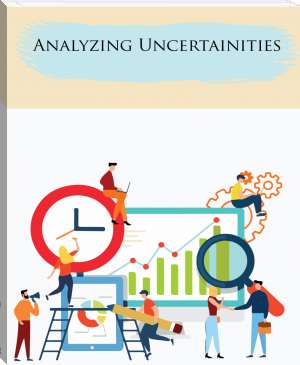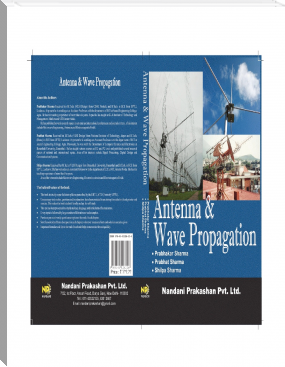Analyzing Uncertainties by Tehzun Kachwala, Kettan Sharma, Pratik Patil, Gurjinder Singh (top reads TXT) 📖

- Author: Tehzun Kachwala, Kettan Sharma, Pratik Patil, Gurjinder Singh
Book online «Analyzing Uncertainties by Tehzun Kachwala, Kettan Sharma, Pratik Patil, Gurjinder Singh (top reads TXT) 📖». Author Tehzun Kachwala, Kettan Sharma, Pratik Patil, Gurjinder Singh
What is Qualitative Risk Analysis?
Imagine yourself as a project manager working for Bank of North America, creating a new loyalty credit card for Java Coffee Beans company. It is likely that few things will not go according plan during a project. To keep things under control in a project we need to carry out activities which help in managing risks before the project begins. The process of managing risks includes few important steps which are identifying, analyzing, selecting appropriate response to the risks and to monitoring them in the project. As we know that there are two approaches to risk analysis which are quantitative and qualitative risk analysis, in this part of the book we will further learn more about qualitative risk analysis.
Qualitative risk analysis is the process to assess individual characteristics of project risk where probability of its occurrence and its impact on the project are measured on a scale of high, medium, low according to their impact. As we know risks are uncertain. Its impact can also be uncertain which can impact numerous project elements such as scope, schedule, budget deliverables etc. Such risks can be expressed either in percentage or numeric from. The scale can be customized according to the organizational needs or desire to maintain the consistency of the scale.
Prioritizing risk according to their probability and impact is the main process in qualitative risk analysis. A project manager can prioritize risk by evaluating the probability and impact of the risk and then focus on the most significant risk. Improving the understanding of project risk is one of the main purposes of qualitative risk analysis. During the process of analyzing risk the project manager can discover all the affected elements of project also the assumptions related to it. All this information is important to create the risk response.
Qualitative Risk Assessment
Assessing an estimate of the severity of a risk is a very important process. Without completing this project managers any work will turn out to be of little or no importance and will be considered as a waste of time. Qualitative risk assessment is the important process in qualitative risk analysis. This process is also easy and can always be performed. The consequences of risk or its impact is always defined in terms of a scale where 1 is the lowest and 5 is the highest. It is not necessary to use a level 5 scale; any type of scale can be used. The type of scale totally depends on the organization or the project manager, but mainly level 5 scale is used.
The Risk Matrix
It is the combination of likelihood and impact in this risk matrix which helps in providing measurements of severity of risks. A risk matrix may contain 5x5 or 6x6 array of elements depending on the level of risk assessment. All the level represents values of likelihood and impact. The risk matrix is normally divided in multiple zones consisting of color codes of red, yellow, green which represents major moderate and minor risk respectively.
Risk Rankings
A project will always have uncertainties. At times a project can have large number of identified risks. In such situations it can often seem difficult to decide which risk should be dealt first. In such situations risk ranking system is being used which is based on position in the matrix to determine the order of priority due to which a finer line of classification of risk is being used then the simple level 3 method.
Management Priority Order
Deciding on which risk to deal with first or to keep any risks on priority is a continuing problem. It is considered that having ten or more than ten risk is a disaster in the project. It means that the project team is ignoring many severe risks connected to it which can result in project failure. Whereas on the other hand it is said that if we only have one or two risks in the red zone then it is a waste of time to follow the top ten risks method.
Concepts of risk assessments is mainly based on the probability of its impact precision and likelihood. Severity of risk is determined by its impact and likelihood whereas precision defines its level of confidence in estimating its severity. Risk assessment is the simplest task. It simply a matter of comparing what you are aware about the risk or have learned about the risk using the scales. Whereas to measure precision your level of confidence is considered as an estimate of the result.
It is the “Process of numerically analysing the combined effect of identified individual projects risk and other sources of uncertainty on overall project objective” (PMI, 2017). In simple terms, we prioritize individual risk according to their overall effect on project. As, in the case of BONA where we know that there are many risks, we can discuss a few of them and prioritize them according to there overall effect on the project. But before that we must take some inputs and we use some tools and techniques and the get our output. So, let’s first dig into it.
For performing the Quantitative risk analysis, we need data and that can be extracted from the process we did before, so let’s see what main inputs we are require here: -
Project Management Plan: It’s the most important input in doing any process of project and same applies here. We need input from project management plan, but we don’t need all plan we need most important plans so let’s see which we require,
Risk Management Plan: As we are doing risk, we need to know how our plan is to handle risk hence we take inputs from the risk management plan.
Scope Baseline: scope baseline is minimum scope requirement for project, and we need to keep on comparing it in risk as to know that any risk is not adding the scope in jeopardy.
Schedule Baseline: we also need to follow the schedule as risk may affect the schedule and its effect on schedule may vary our baseline.
Cost Baseline: Cost is important factor of project and maintaining it is of high priority and risk effecting it is always kept in front and monitored.
Project Documents: The project documents include various documents for managing the project and their input for Quantitative risk analysis is important. So, let’s see what documents we are dealing here,
Assumption Log: It is most important document that affects the project as it makes assumptions about risks that may or may not be true but can lead a project into risks.
Basis of Estimates: As we know there are various methods of estimation and that documents are very important while performing risk analysis and prioritize the risks.
Cost Estimates: Cost drives the project and how it is estimated is important as risk effects cost.
Cost Forecast: while planning any project we forecast some cost and in Quantitative risk some time forecast can fail hence we need to take data from there as well.
Duration Estimates: Schedule is one of triple constraints and its estimates must be considered when some risk can delay project.
Milestone List: Its list of key objectives in the project and must be maintained and looked after, most of the time budget is released in this time.
Resource Requirements: The resource requirement is important factor and data from it must be considered.
Risk Register: This is live document for handling risk because we start and note everything about risk over here. So, its input is important.
Risk Report: It shows us sources of overall risk and current risk on overall project hence we update it while performing risk response.
Enterprise Environmental Factors: Enterprise environmental factors can influence the process and such factors are Industry study of similar projects, risk databases or checklists.
Organizational Process Assets: The assets such as previous similar projects are important for performing the project.
We use many tools and techniques to perform this process by taking input we analyze the situation to performing Quantitative risk analysis.
So, let’s see some Tools and techniques we are using:
Expert Judgement
Data gathering
Interviews
Interpersonal and team Skills
Facilitation
Representation of uncertainty
Data Analysis
Simulation
Sensitivity analysis
Decision tree analysis
Influence diagrams
So, with these tools and techniques we implement and prioritize the project risk from its effect on overall project.
 The desire to acquire knowledge about the surrounding world and human society is quite natural and understandable for a person. Life is so developed that an uneducated person will never occupy a high position in any field. Humanity in its mass, and each person individually, develops objectively, regardless of certain life circumstances and obstacles, but with different intensity. The speed of development depends on the quality of training.
The desire to acquire knowledge about the surrounding world and human society is quite natural and understandable for a person. Life is so developed that an uneducated person will never occupy a high position in any field. Humanity in its mass, and each person individually, develops objectively, regardless of certain life circumstances and obstacles, but with different intensity. The speed of development depends on the quality of training.




Comments (0)